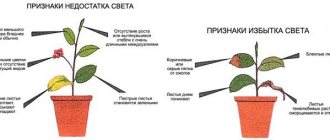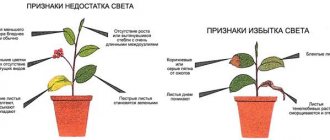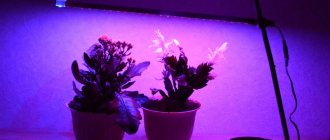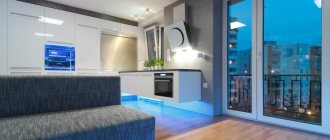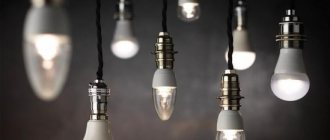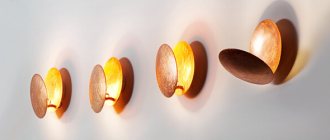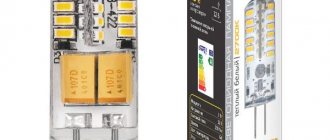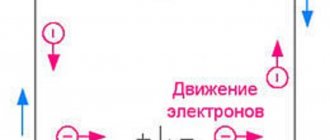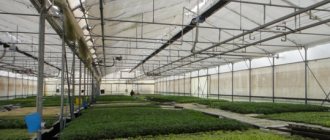Recently, in the field of indoor gardening, there has been an increasing interest in LED lamps for growboxes and LED lamps. Diodes have low power consumption, do not heat up as much as HPS, and do not require additional devices for connection. In this article we will try to understand the pros and cons of this type of lamps and understand where and what the benefits are for the gardener.
LED (Light Emitting Diode)
is a semiconductor device that distorts electrical voltage into light. The spectral range of emitted light depends on the chemical composition of the semiconductor. In appearance, this is almost an ordinary lamp with many LEDs in it. These things were invented back in 1907, but they were developed relatively recently for the needs of crop production. Despite the fact that LED lamps for plants have just entered our lives, they have already managed to create a good reputation for themselves.
How to choose LED lighting for a growbox?
Not all LED lamps are suitable for lighting plants indoors. When choosing, it is necessary to take into account the optical wavelength or, in other words, the range of the emission spectrum
. There is a direct connection between the efficiency of photosynthesis, the amount of rays received by the plant and their spectral composition. Most favorable for plants:
- blue spectrum 430–455 nm, used for lighting during the growing season (the blue-violet range helps in the creation of growth inhibitors that promote plant formation, increasing its density and strength);
- red spectrum 660 nm, used at the flowering stage of plants (the red-orange wavelength range is responsible for the development of fruits, roots, and growth of tops volume).
The remaining ranges are much less effective for backlighting.
Different types of plants, as well as stages of their growth, require different ratios of the blue and red components of the spectrum. Therefore, when choosing an LED panel or lamp, it is necessary to take into account the emission spectrum. It is better to choose multispectral LED lamps, otherwise you will have to buy one unit for the vegetative stage of plant development and a second one for flowering.
The second important characteristic when choosing an LED is power
. It must be selected based on the required lighting area. Let's look at the common types of LED devices and their characteristics:
- Phytolamps with a power of 5-15 W are well suited for illuminating one or two plants, illuminating an area of up to 0.5 square meters; Phytolamps with a power of 21-27 W – cover an area of up to 0.6-0.65 square meters with light.
- A round LED phytolight with a power of 80-150 W is perfect for additional lighting of plants.
- Rectangular LED lights with a power from 150 W to 800 W are the best solution for fully illuminating plants, without the use of natural light.
- Phyto tapes are a solution that offers an advantageous combination of price and quality and is suitable only for supplementary lighting of plants; they cannot replace natural lighting.
Options for placing lighting for seedlings
- Individual illumination of plants with LEDs.
- Racks for plants.
Individual plant lighting.
Spot lighting of plants will not only avoid the annual relocation of all pots and flowerpots to the wintering place, but also create a unique, inimitable interior design. Miniature but powerful LEDs can be used as a lighting source.
LEDs for illuminating plants are capable of producing up to 120 lumens and can be used both as illumination for a plant and as a night light.
For individual lighting, you can buy a specialized LED phytolamp, which we wrote about above. The calculation method is the same as for the LED strip.
Racks for plants.
If there are a large number of lighting objects, it is more advisable to make shelves at the bottom of which the LED strip for plants will be mounted.
Racks can be protected with reflective materials: foil, metallized insulation. This will provide round-the-clock illumination, but will not interfere with rest in the evening. Also, such a screen will increase the illumination of plants by 10-15 percent.
Please rate the article. We tried our best:)
Did you like the article? Tell us about her! You will help us a lot :)
Advantages of LED plant lighting
- LED panels and phytolights are excellent for home greenhouses, winter gardens, and grow tents, as they emit significantly less heat (compared to HPS). Therefore, when using them, you do not need a separate fan to remove hot air, as with sodium lamps. The optimal height of the suspension is 30-50 cm from the upper leaves of the plant.
- LED lamps do not require additional devices, such as ballasts and ISUs, which are necessary to connect sodium lamps. LED panels and lamps are connected with a standard wire directly to a 220V network, thanks to which the risk of fire or short circuit practically disappears.
- Due to its design, the LED produces a strictly directed beam of light and does not require a reflector.
- LED lamps consume 4-5 times less electricity than sodium lamps. The power consumption declared by the manufacturer will actually be even lower, since it only indicates the size of the crystal and its potential, and less current is supplied. For example, the actual power consumption of a 15 W lamp = 8.5 W.
- Long service life - up to 50,000 hours. Provided that the lamp or lamp you choose will not overheat and burn out.
- Quick installation.
- Does not require constant monitoring and preliminary preparation of the area for placement.
- LED plant lighting is harmless to humans and the environment - it does not contain mercury or other hazardous substances.
Calculation of the required level of illumination
Properly selected LED lighting for plants will allow pets to develop normally and delight their owners with their beautiful appearance.
When making calculations it is necessary to take into account:
- type of indoor flower;
- distance from the lamp to it;
- the area to be illuminated.
Important! When placing the light source above the plants, there is no loss of light flux. So, when the lamps are at a height of 0.3 m, approximately 30% of the flux will be lost.
Lamp at a height of 30 cm from the flowers
Illumination refers to the amount of luminous flux (in lumens) falling per square meter of base.
For example, you need to calculate the required number of lamps to illuminate a shelf with flowers 1 m long and 30 cm wide. The structure area will be 0.3 m2. To create an illumination of 5 thousand lux, you will need light sources with a luminous flux of 1500 lm. Considering the 30 percent loss, it is necessary to create a flow reserve. Thus, the required amount of luminous flux will increase to 1950 lm.
The luminous efficiency of various light sources is known. Knowing them, it is not too difficult to calculate the lamp power required to organize the lighting.
Light output indicators of various light sources
- Standard incandescent lamps. They have a light output of about 12 - 13 lm/W. The power that the light sources should have is determined: 1950 divided by 12, it turns out 162.5 W. To provide the required illumination, you will need 3 lamps of 60 W each.
- Luminescent sources. The lamps have a light output of 65…70 lm/W. Accordingly, the power of the lamps should be 30 W. To illuminate plants, you can limit yourself to two 15 W lamps.
- LEDs. Their light output is approximately 100 lm/W. Such light sources should provide a power of 19.5 W. You can take 3 lamps of 7 W each.
But it should be taken into account that the calculations were made when installing lighting at a height of 30 cm above the flowers. If the distance is greater, losses will increase significantly.
Dependence of illumination on the height of the lamp
Disadvantages of LED
The main limiting factor in the spread of this type of lighting is price. Let's compare the cost of the LED Apollo 4 lamp (power 140 W, lighting area about 60*60 cm) and the HPS 250 W kit (Super HPS lamp 250 W + EMP 1-K-250 W + indoor lamp CoolMaster 100 + fan GARDEN HIGHPRO 160). LED Apollo 4 costs 15,600 rubles, the DNAT kit costs 11,700 rubles.
Well, if you purchase separate blocks of LEDs for the vegetative stage and for flowering, then, ultimately, this will lead to an even greater increase in the cost of the lighting system.
The second common problem with LEDs is overheating and, as a result, burnout. Therefore, it is better to choose a lamp with active cooling. These include Apollo phytolights, which we will discuss further.
It is better not to save money on purchasing LED lamps. Choose LEDs with a guarantee, from reliable manufacturers, read reviews. As a rule, cheap Chinese LEDs quickly fail, and they are difficult to repair, since few people do this.
A little about LED design
LED crystals emit almost monochrome light, depending on the semiconductor material. To obtain a yellow, white or the same “full for plants” spectrum of radiation, a phosphor coating is used, which converts primary radiation into secondary radiation using photoluminescence. Typically, such an LED consists of a housing with a substrate and leads onto which the LED crystal, silicone lens, shaping the direction of radiation, a gasket with a phosphor and a protective cap made of transparent plastic.
In this design, the brightest LED crystals with a blue and violet spectrum are most often used. Engineers around the world are struggling to increase light output and improve the spectrum and other characteristics of the LED. Our Chinese friends, hiding behind high technology, are looking for ways to reduce the cost of goods and conquer the market, from banal deception (what are the same Chinese watts worth))), to searching for the cheapest components. In order to understand a little about the market conditions for LEDs for plants, I purchased several sets of 3-watt “beads” from different manufacturers: Expensive Bridgelux LEDs with “full spectrum” LEDs on Epiled chips with “full spectrum”, the cheapest in the review LEDs with Taiwanese Epistar chips with “full spectrum” 440 and 660 nm LEDs with Epistar chips Conventional warm white LEDs used in lighting lamps
At first glance they all look like identical twins)))
But turning on the LEDs revealed an interesting feature. If the Epiled and Bridgelux LEDs behind the phosphor have a 42mil or 45mil square die
Then the Epistar crystal has a clearly rectangular shape
The current-voltage characteristic showed a clear difference between the crystals
The yellow LED showed the greatest voltage drop on the crystal, and therefore the electrical power. The smallest is Epistar. I did not present the characteristics of 440 and 660 nm LEDs here; they can be found in this review. Spectral analysis using a jewelry spectrometer showed that LEDs for plants have characteristics close to those declared
Since I do not have an accurate spectrometer, it is not possible to compare the quantitative components of the spectrum.
To identify the differences, I decided to conduct
LED lamps Apollo
Apollo is a multi-spectral full-fledged luminaire that provides illumination for plants throughout their entire life cycle. The diodes in Apollo lamps operate in five spectra. Color of diodes per segment (nm*pcs): 660*3, 630*6, 470*3, 595*1, 6500*2. According to the manufacturer itself, the Apollo 4 lamp works with the same performance as a 420 W HPS lamp.
Well, to top it off, we publish a spectrogram of the Apollo 140 lamp, 150 W and 250 W HPS lamps.
As you can see, the peak in the blue region of LED Apollo 140 is much higher, which will have a beneficial effect on the vegetative development of the plant. LED Apollo 140 has a clearly defined peak in the red region, while for 150 and 250 HPS it is shifted closer to the yellow spectrum, which is less effective for plant development. The PAR (total photosynthetically active radiation) indicator for the LED Apollo 140 and the 250 W HPS lamp is generally comparable - 161 versus 172.
Conclusion: with the same absorbed watts, the LED Apollo lamp produces more “useful” lighting than HPS 150 and 250 W.
Result:
What conclusions did I draw for myself?
1. Not all yoghurts are equally useful. In this case, cheap LEDs on Epiled crystals turned out to be less effective for plant growth and there is no point in using them. Apparently, in addition to cheap crystals, they use a lower-quality phosphor, otherwise there is no way to explain how they give worse results at higher power.
2. And the opposite conclusion is that an expensive product is not always a guarantee of quality. I don't want to say anything bad about the American company Bridgelux. Most likely, everything I'm dealing with is a fake. The characteristics of this “Bridgelux” and Epiled are too similar. These expensive phyto-LEDs are no better than their cheap counterparts.
3. For illuminating plants, ordinary white LEDs are quite suitable, providing growth on an equal basis with special ones, both with single crystals of 660 and 445 nm, and phosphors with a “full spectrum”
4. Careful selection of components on Aliexpress allows you to make a more or less optimal choice. Thus, Epistar “full spectrum” LEDs, as per the link to the product in this topic, allow for plant growth with a 20% reduction in lamp power relative to white LEDs.
Everything stated in this article is my personal observations and experience.
For more accurate results, much more research using instruments is needed. What criteria does a cat use to evaluate grass remains a mystery to me?
Hybrid lighting – LED + HPS
When growing highly productive plant hybrids, the combination of HPS + LED can provide a significant increase in yield. Let's take a closer look.
So. HPS lamps with a power of 400 W and higher provide a powerful stream of red light, which is so important for flowering and fruiting. In addition, DNAT is much more multispectral than red-blue diode lamps. LED, on the other hand, emits a minimum of heat - the working surface of a 280W LED lamp barely reaches 40 degrees compared to 200 degrees of HPS, and this is a huge advantage. Thus, if you use a powerful flow of HPS and illuminate the sides with LED panels, then the HPS indicators in lumens will increase from 60000-95000 to 100000-160000, without increasing the temperature in the grow room and saving energy!
At the moment, in Western grow reports you can increasingly find the following type of lighting: 1 HPS and several LED lamps. The result is something previously unimaginable!
To reinforce the information, watch the video from our YouTube channel:
How to choose the best lamp option
For indoor flowers, the following lighting modes should be used:
- 1000 -3000 lux – for growing in a darkened room, far from the window;
- 3000 – 4000 lux – for those who need a diffused flow of light;
- 4000 – 6000 lux – for those in need of direct lighting;
- 6000 – 12,000 lux – for exotic fruit-bearing species.
Beautiful flowers are the key to comfort in your home
You can find detailed information about the properties and rules for choosing phytolamps for seedlings here.
Red LEDs are needed by plants when they bear fruit or bloom. There are two waves of red LED: weakly absorbed and far. Promotes the formation of group A chlorophyll. Diode lamps use more red lamps than white or blue ones.
Using blue and red LED strips
As an economical option for illuminating indoor plants, red (630nM) and blue (465nM) LED strip can be used. Their peak intensity is somewhat shifted from the phytospectrum, but this is not critical; the effectiveness of such lighting will decrease, but only slightly.
LED strips of red and blue spectrum
Instead of two strips of different colors, you can use one RGB, but to control its operation, in addition to the power supply, you will need a special controller, which makes the design more expensive.
https://www.youtube.com/watch?v=WD_dRwpvje8&feature=youtu.be
Types of lamps for illuminating plants
A wide range of lamps for plants of different types makes their choice difficult. Before purchasing a device, you should familiarize yourself with its characteristics. The purpose of the installation should be determined in advance - growing seeds from scratch or adjusting the development of already green stems. Each model has its own advantages and disadvantages.
Incandescent lamps
They are rarely used as backlight due to low light output and high heating. It is generally not recommended to place such devices near plants. From a long distance, the backlight will not be effective. Flower growers use incandescent lamps to create favorable temperature conditions in greenhouses and aquarium tanks.
Plants need lighting only a few hours a day, provided the pots are on the windowsill. But even such short-term operation of devices will be very energy-consuming.
If you use an incandescent lamp together with fluorescent devices, you can successfully supplement the spectrum with red color.
Fluorescent lamps
It is advisable to use in small areas. Standard models will not speed up plant growth. A device with a two-component phosphor coating and maximum radiation of the red and blue color spectrum will help ensure photosynthesis.
There are household and professional devices. When choosing a model, you need to pay attention to the luminescence range. It must correspond to a specific case: for full illumination of small aquariums, for additional lighting of individual zones, for greenhouses in combination with additional sources. Fluorescent lamps have the following advantages:
- Provide excellent light output with low power consumption;
- They have a wide range of shades;
- Emit soft, diffused light;
- They can work up to 15 thousand hours.
Gas discharge lamps
A large group of lamps for seedlings, which includes high and low pressure devices. All models are absolutely harmless, which allows them to be used in large quantities in greenhouses and residential premises. The following types of gas discharge devices are used for plants:
- Metal halide. Very bright radiation with a stable luminous flux is suitable for industrial cultivation and spacious greenhouses. Maximum similarity of artificial radiation with daylight (up to 95%). The blue spectrum predominates, which contributes to the formation of young seedlings. Cons: high price. Possibility of explosion when voltage increases.
- Sodium. They shine in the red-orange spectrum due to the gaseous environment created by sodium vapor. Suitable for use during flowering and fruit set. Durable, economical devices are often small in size, which allows the emitter to be directed in the desired direction. Disadvantages - high heating, attracting insects and pests, creating noise, poor lighting in the cold. Instant failure if any liquid gets into the lighting fixture.
- Mercury. The radiation is in the red spectrum, which has a positive effect on the development of already formed plants. But this option for additional lighting is rarely used due to a large number of negative factors. These include strong light pulsation, low color rendering index, and high ultraviolet radiation.
LED bulbs
Ideal supplementary lighting option. The variety of models allows you to install devices both in large greenhouses and on a small windowsill. For shelving, wireless lamps are used, for example, from aliexpress. The spectral range includes all the necessary shades for the growth of seedlings. By installing LEDs of different power, you can get the ideal additional lighting for a certain type of seedling.
LED lights can be placed very close to the seedlings without the risk of burning the leaf blades. They turn on instantly and provide an even glow. Depending on the number of seedlings and the type of racks, models of the following shapes are used:
- Phytopanel or tablet. A professional lamp in the form of a large square is installed above wide shelves;
- Pipe. Used to illuminate plants located on window sills, on long, narrow shelves along the wall;
- LED spotlights. Illuminate an impressive area from a great distance;
- Single lamps. Used for flowers of the same type, collected together;
- LED strips. Lamps are made by hand, combining the colors of the spectrum in any order.
Plants and light: the need for lighting
Energy is required for the growth and development of any living organism. Photosynthesis helps initiate this process in plants. Only under the influence of sunlight can the green parts of crops develop properly. Even if a flower receives enough moisture and nutrients in the form of fertilizers, but not enough light, it will look depressed.
The illumination procedure is carried out in the morning or evening, without depriving the plants of the natural sun at dawn and sunset. Crops should not be exposed to artificial lamps for more than 12 hours. You can determine the need for additional lighting for different species using a lux meter. For shade-loving plants, 2000 lux will be enough; for light-loving plants, 2500 lux will be enough, with the condition of increasing the indicator to 5000 at the time of bud setting and flowering. Lemons and oranges will be able to form an ovary on the windowsill only with high illumination - 9000 lux.
To provide illumination, lamps of various types can be used. Among the recommended ones are gas-discharge, fluorescent, and LED. It is better not to use household incandescent lamps with tungsten filament. They provide low light intensity, their bright infrared rays excessively accelerate the growth of the crop, which makes the stems elongated and the leaves small.
How to use a phytolamp
Each grow light comes with instructions for use. It is necessary to correctly calculate the height of the phytolamp suspension, the distance to the seedlings, the required power and the radiation spectrum. If the seedlings look healthy, then all parameters are set optimally.
As the plants grow, it is necessary to adjust the spectrum, power and height at which the phytolamp is located above the crops.
This applies to growing plants on the windowsill and in industrial premises. In the first case, phytolamps cannot be covered with anything. In the second, greenhouses must be equipped with powerful cooling radiators to maintain the required temperature conditions so that the plants do not overheat.
Number of lamps and installation rules
Favorable development of plants occurs with sufficient lighting. This indicator can be improved not only by the quality of the radiation, but also by the number of devices themselves. The required number of lamps is calculated for specific conditions. In order to correctly make calculations and provide plants with high-quality illumination, the following aspects must be taken into account:
- Room area;
- Number of seedlings;
- Distance from devices to tall crops;
- Illumination angle;
- The need for additional light for each specimen.
Phytolamps will have maximum effect if they are positioned correctly in the apartment. Most light radiation comes from the devices closest to the plants. The minimum distance from the light bulb to the seedlings is 25 cm. They must be aimed strictly at the crops.
The relevance of the use of LED phytolamps
Different houseplants need different levels of light. Due to lack of light, some stop blooming, others begin to stretch out and get sick. It is easy to draw a conclusion about the relevance of using a phytolamp based on your own observations. If you are sure that enough sunlight penetrates into the room through the window openings, then it makes no sense to use LED lamps for indoor flowers or any plants. For example, begonia and zygocactus develop and bloom well on a windowsill with access to the west.
There is no need to collect additional lighting for residents of the southern regions, where direct sunlight feeds the leaves of houseplants for several hours every day.
Check, maybe the reason for poor growth lies in improper watering or inappropriate soil composition?
For residents of the northern regions of the country and those whose windows are deprived of sunlight, an LED lamp for growing plants will become an assistant in their green farming. And to accelerate the growth rate of seedlings, you simply cannot do without a phytolamp.
How to properly illuminate seedlings
For maximum effect, phytolamps must be installed above the plants. It is necessary to ensure that the light falls on the plants at a right angle of 90°. If the installation is carried out from the side, then the sprouts, tending to the light, will bend and subsequently break due to the weight of the harvest.
To grow seedlings or plants at home, you should buy a phytolamp with a built-in diffuser. You can build a reflector from shiny surfaces so that sunlight does not go into the room, but returns to the plants. Reflectors are also needed if a phytolamp with a spectrum that affects the human visual organs is used.
Full Spectrum LED Manufacturers
Proven and reliable Russian manufacturers are:
- Optogan;
- Optocoupler;
- Artleds.
Global manufacturers:
- Agilent Technologies is a company that has been producing high-quality LED lamps for several years. The manufacturer provides a guarantee for lamps for at least 10 years and produces lamps with various combinations of lamps.
- Optek Technology is a high-level manufacturer. It has firmly taken its place in the global market in the production of LED lighting. Produces various lamps of excellent quality.
- Edison is a well-known manufacturer that is in no way inferior to its competitors. It produces specialized LED lamps for a wide range of uses: in medicine, cosmetology, and also for growing front gardens.
- Philips Lumileds - over the years, this company has gained the trust of many customers. Produces the best lamps for LED lighting. Provides a long warranty on all products.
- Toshiba is a company that successfully produces LED lamps of various configurations and types. The quality of the product is at the highest European level.
